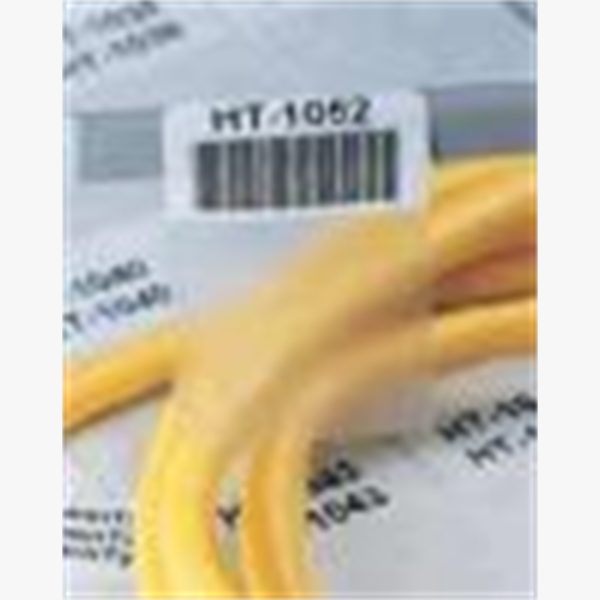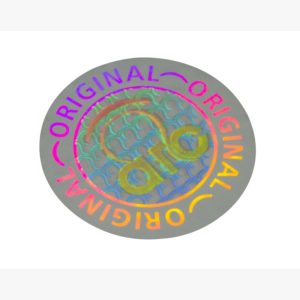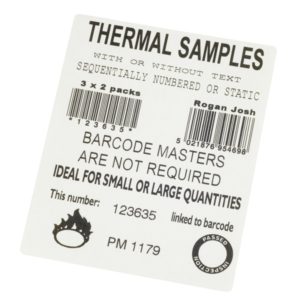Cable / Wire Marking Labels
Home / Full Product Range / Industrial and Security Labels / Cable / Wire Marking Labels
For the easy identification of cables and wires, use ‘cable-wrap’ labels, available in customised sizes, colours and with variable data. It proves to be a suitable alternative to ‘flag markers’ which can tear or degrade, or when something more discreet is required. The labels comprise of a white (or other coloured) portion which contains the information, and a clear ‘tail’. The principle behind these labels is simple. Just apply at 90 degrees to the cable so that the clear ‘tail’ self laminates around the cable and the printed information. This ensures a permanent seal which prevents tearing and scuffing and, enables its use in an outdoor environment. The size of the information area is entirely up to you, and can be supplied blank (plain) or pre-printed with information including text, logos, serial numbers, or even barcodes. The background colour can be co-ordinated with a particular cable which will enhance its identification. Our large selection of wire and cable marking products allows you to choose the identification solution that best meets your requirements. We offer a wide range of custom materials for wire marking labels that are manufactured to your exact specifications. Either pre-printed or plain, allowing you to overprint or write on subsequent information. Available as either self adhesive wraparound labels or non adhesive tags.
Cable Wire Marking Labels FAQs
Cable wire marking labels are used to tag different types of cabling and loose wires, and provide users with information about circuit details, connection points, and identification numbers. They are usually made from materials that can withstand outdoor conditions (such as heat, moisture, and abrasion).
Wrap Around Labels
Wrap around labels, as the name suggests, are designed to wrap around cables and wires. They are often made from vinyl and feature a printable area covered by a clear laminate, which protects the information from dirt and abrasion. These are ideal in industrial settings where durabilty is most important.
Self-Laminating Labels
Self-laminating labels have a printable section and a clear laminate that wraps around for extra protections. They are commonly made from polyester or vinyl and they are perfect for manufacturing plants or outdoor installations which get exposed to moisture and chemcials.
Sleeves
Sleeves most distinguishing feature is their tubular shape that slides over cables before connects, they then shrink to fit when heated. They are most often found in aerospace, automotive, and industrial environments thanks to their tight fit, resilience to stress, and resistance to extreme temperatures.
Tags
Tags are flat labels attached with cable ties, and are suitable for larger cables when adhesive labels may not stick well. These types of labels are usually found in power distribution and heavy industry. They give uses clear, visible labeling while being easy to re-label.
Flags
Flag labels extend outward from a cable, which gives more room for detailed information. These are most commonly used in telecommunications and data centres, they let users clearly see and identify different cables without having to move around sections of densely packed cables.
### Carriers and Insert Labels
Carriers and insert labels use a clear plastic clip-on carrier with an insertable printed label. They are mostly found in data centres and IT environment where configurations change frequently, making for much easier updates and replacements.
### Heat Shrink Wire and Cable Labels
Heat shrink labels are heat-sensitive tubes that shrink to fit cables snugly. Their main advantage is higher durability and resistance to moisture, chemicals, and abrasion – good for harsh environments and sectors like aerospace, automotive, or general industrial applications.
### Cable Markers
Cable markers are small and colour-coded and can be clipped or wrapped around cabled. They are primarily used for phase identification or circuit numbers, and are found in electrical installations and control panels for at-a-glance identification.
Cable and wire labels typically display a unique identification number or code, the type of cable (CAT6, fibre optic), voltage, and current ratings. They also usually include a circuit number, source and destination point, installation date, and installer details.
Some other details include cable legnth, special usage instructions, safety warnings, company name or logo, compliance marks, and suitable environment conditions. This information is both to comply with regulation as well as help with clear identification and safe usage.
The UK has specific standards for cable wire marking labels – the key standards are BS 7671 (IET Wiring Regulations) for electrical installation and proper cable identification. BS EN 60617 and BS EN 60947-1 for guidelines around graphical symbols and low-voltage switchgear markings. BS EN 60204-1 specifies safety requirements for machinery’s electrical equipment, including labelling. BS 1710 covers the identification of pipelines and services, including electrical conduits, while BS 3858 focuses on conductor and cable identification.
Additionally, ISO/IEC 11801 is referenced for network cabling systems, and the Electricity at Work Regulations 1989 mandate suitable conductor identification to prevent danger. For more detailed information about these regulations, it’s best to contact a law firm that specialises in this area.
Cable wire marking labels are usually made from durable materials to stand up to either the harsh conditions found in industry or to withstand the outdoors (or both). Some examples are vinyl (flexible and resistant to moisture and abrasion), polyester (durable and resistant to chemicals), polyolefin (usually used in heat shrink labels as it is can shrink to a tight fit more easily). Some labels can be made from nylon (flexibility in tight spaces) or metal (for the most durable labels needed in the harshest conditons).
Cable wire marking labels come in all kinds of shapes and sizes. The most common sizes can be as small as 1 inch by 0.5 inches for thin wires, to up to 4 inches by 2 inches for bigger cables. Common shapes are rectangular (for general use) flag labels (for wrap arounds and easy reading), or wrap arounds that fully encircle a cable. There’s also sleeves (usually on heat shrinks) and labels designed to be attached with cable ties.
For the easy identification of cables and wires, use ‘cable-wrap’ labels, available in customised sizes, colours and with variable data. It proves to be a suitable alternative to ‘flag markers’ which can tear or degrade, or when something more discreet is required. The labels comprise of a white (or other coloured) portion which contains the information, and a clear ‘tail’. The principle behind these labels is simple. Just apply at 90 degrees to the cable so that the clear ‘tail’ self laminates around the cable and the printed information. This ensures a permanent seal which prevents tearing and scuffing and, enables its use in an outdoor environment. The size of the information area is entirely up to you, and can be supplied blank (plain) or pre-printed with information including text, logos, serial numbers, or even barcodes. The background colour can be co-ordinated with a particular cable which will enhance its identification. Our large selection of wire and cable marking products allows you to choose the identification solution that best meets your requirements. We offer a wide range of custom materials for wire marking labels that are manufactured to your exact specifications. Either pre-printed or plain, allowing you to overprint or write on subsequent information. Available as either self adhesive wraparound labels or non adhesive tags.
Cable Wire Marking Labels FAQs
Cable wire marking labels are used to tag different types of cabling and loose wires, and provide users with information about circuit details, connection points, and identification numbers. They are usually made from materials that can withstand outdoor conditions (such as heat, moisture, and abrasion).
Wrap Around Labels
Wrap around labels, as the name suggests, are designed to wrap around cables and wires. They are often made from vinyl and feature a printable area covered by a clear laminate, which protects the information from dirt and abrasion. These are ideal in industrial settings where durabilty is most important.
Self-Laminating Labels
Self-laminating labels have a printable section and a clear laminate that wraps around for extra protections. They are commonly made from polyester or vinyl and they are perfect for manufacturing plants or outdoor installations which get exposed to moisture and chemcials.
Sleeves
Sleeves most distinguishing feature is their tubular shape that slides over cables before connects, they then shrink to fit when heated. They are most often found in aerospace, automotive, and industrial environments thanks to their tight fit, resilience to stress, and resistance to extreme temperatures.
Tags
Tags are flat labels attached with cable ties, and are suitable for larger cables when adhesive labels may not stick well. These types of labels are usually found in power distribution and heavy industry. They give uses clear, visible labeling while being easy to re-label.
Flags
Flag labels extend outward from a cable, which gives more room for detailed information. These are most commonly used in telecommunications and data centres, they let users clearly see and identify different cables without having to move around sections of densely packed cables.
### Carriers and Insert Labels
Carriers and insert labels use a clear plastic clip-on carrier with an insertable printed label. They are mostly found in data centres and IT environment where configurations change frequently, making for much easier updates and replacements.
### Heat Shrink Wire and Cable Labels
Heat shrink labels are heat-sensitive tubes that shrink to fit cables snugly. Their main advantage is higher durability and resistance to moisture, chemicals, and abrasion – good for harsh environments and sectors like aerospace, automotive, or general industrial applications.
### Cable Markers
Cable markers are small and colour-coded and can be clipped or wrapped around cabled. They are primarily used for phase identification or circuit numbers, and are found in electrical installations and control panels for at-a-glance identification.
Cable and wire labels typically display a unique identification number or code, the type of cable (CAT6, fibre optic), voltage, and current ratings. They also usually include a circuit number, source and destination point, installation date, and installer details.
Some other details include cable legnth, special usage instructions, safety warnings, company name or logo, compliance marks, and suitable environment conditions. This information is both to comply with regulation as well as help with clear identification and safe usage.
The UK has specific standards for cable wire marking labels – the key standards are BS 7671 (IET Wiring Regulations) for electrical installation and proper cable identification. BS EN 60617 and BS EN 60947-1 for guidelines around graphical symbols and low-voltage switchgear markings. BS EN 60204-1 specifies safety requirements for machinery’s electrical equipment, including labelling. BS 1710 covers the identification of pipelines and services, including electrical conduits, while BS 3858 focuses on conductor and cable identification.
Additionally, ISO/IEC 11801 is referenced for network cabling systems, and the Electricity at Work Regulations 1989 mandate suitable conductor identification to prevent danger. For more detailed information about these regulations, it’s best to contact a law firm that specialises in this area.
Cable wire marking labels are usually made from durable materials to stand up to either the harsh conditions found in industry or to withstand the outdoors (or both). Some examples are vinyl (flexible and resistant to moisture and abrasion), polyester (durable and resistant to chemicals), polyolefin (usually used in heat shrink labels as it is can shrink to a tight fit more easily). Some labels can be made from nylon (flexibility in tight spaces) or metal (for the most durable labels needed in the harshest conditons).
Cable wire marking labels come in all kinds of shapes and sizes. The most common sizes can be as small as 1 inch by 0.5 inches for thin wires, to up to 4 inches by 2 inches for bigger cables. Common shapes are rectangular (for general use) flag labels (for wrap arounds and easy reading), or wrap arounds that fully encircle a cable. There’s also sleeves (usually on heat shrinks) and labels designed to be attached with cable ties.
















